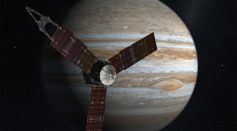Tags: Great red spot
Jupiter’s Great Red Spot Revealed by Supercomputer Simulations; Giant Storm May Not Be Quite as Old as First Thought
NASA's Juno Mission Releases New Photos Featuring Great Red Spot, Potato-Like Shape Moon Amalthea
Great Red Spot: Is The Biggest Storm in the Solar System Shrinking? NASA's Juno Mission Measures the Vortex's Gravity

First 3D View of Jupiter's Atmosphere Shows the Great Red Spot is Deeper Than Expected, NASA's Juno Reveals
NASA Juno Spacecraft Compares Jupiter's Great Red Spot To A Floating Pancake Above the Clouds
Hubble Space Telescope Detects Winds in Jupiter's Great Red Spot Speeding Up to 400 Miles Per Hour, Does This Makes Sense?

NASA Juno Spacecraft Saw Clyde's Spot on Jupiter After a Year: Did Its Apperance Change?

NASA Hubble Space Telescope Shares Photos of Jupiter’s Stunning Stripes Showing Evolving Appearance, Great Red Spot Super Storm

Hubble Captures "Rainbow" Images of Jupiter
Most Popular

Viruses vs Bacteria: Key Differences, How They Spread, and How We Treat Them

How Ice Cores Reveal Climate History: Insights from Paleoclimate Science and Ancient Data

Recycling Myths vs Facts: What Actually Gets Recycled and How to Do It Right

Space Debris and Orbital Pollution: Rising Space Junk Threats and Collision Risks Around Earth




